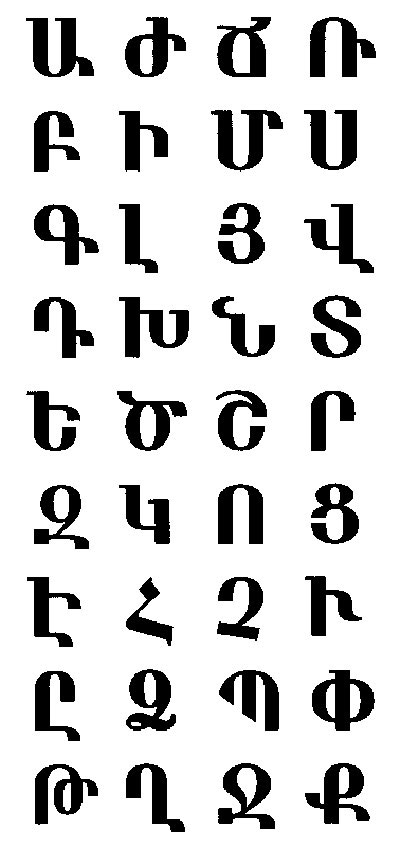Barlow Der Mugrdechian
Advisor
 This year marks the auspicious celebration of the 1600th anniversary of the discovery of the God-pleasing Armenian alphabet. When the pious and virtuous Mesrob Mashtots made this discovery, through the guidance of the spirit of God, the Armenian people received a wonderful gift, an alphabet of thirty-six letters that would completely and permanently alter the nature of the Armenian people. The first book translated into the Armenian language was the Bible, the sacred “Breath of God,” which became the inspiration for generations of Armenian artists and writers.
This year marks the auspicious celebration of the 1600th anniversary of the discovery of the God-pleasing Armenian alphabet. When the pious and virtuous Mesrob Mashtots made this discovery, through the guidance of the spirit of God, the Armenian people received a wonderful gift, an alphabet of thirty-six letters that would completely and permanently alter the nature of the Armenian people. The first book translated into the Armenian language was the Bible, the sacred “Breath of God,” which became the inspiration for generations of Armenian artists and writers.
Armenia’s adoption of Christianity in the fourth century set the course for Armenian history, putting the Armenian people on God’s path, through the centuries of challenges to be faced. And so the Armenians had become Christian, sharing fully in God’s bounty, and prospering as a people and a nation. Yet the lack of an Armenian alphabet hindered the complete evangelization of the people, making the development of the Armenian alphabet a necessity.
The wise St. Sahak, together with the God-fearing King Vramshapouh, supported Mesrob Mashtots in his quest to develop an Armenian alphabet. After much struggle and frequent failure, Mashtots was successful, ushering in a new age of creativity, when the fifth century writers and historians, began to create the original works which would set the foundation for Armenian literature. Koriun, Agatangelos, Buzantatsi, Parpetsi, Yeghishe, Yeznik, and Khorenatsi became the writers of the age of discovery, providing an influence for generations of Armenian writers.
The lyrical, unique, and perfect thirty-six letters of the Armenian alphabet gave the Armenian people an identity that would keep Armenians as Armenian until today. For 1600 years, this alphabet, has been the bulwark against all challenges. It is what makes an Armenian Armenian.
The Armenians have written poems to this language, and sung to this alphabet. In the first words of Siamanto’s poem, “The Glory of Invention,” we see the love and respect accorded to Mashtots.
“Mesrob! You stand an unshatterable diamond rock against time. Against the Armenian centuries.”
We exist today, an Armenian people, living in Armenia, or in the Diaspora, because of Mesrop Mashtots, because of St. Sahak, and King Vramshapouh, whose love and dedication give us a life sustaining spirit. That spirit exists in all those today who speak and write Armenian.
In Yeghishe Charents’ words, “I love the sun-baked taste of Armenian words.”
In the Armenian alphabet God granted the Armenian people the instrument of its survival and its prosperity. May we continue in that spirit for generations to come.
Staff Report

A conference dedicated to the 1600th anniversary of the invention of the Armenian Alphabet was held on Saturday, September 24, on the campus of the University of California, Los Angeles (UCLA).
Seven scholars from throughout California participated in the conference, which was sponsored by the Hamazkayin Educational and Cultural Society, Western Regional Executive Committee, in conjunction with Dr. Peter Cowe, Naregatsi Chair of Armenian Studies at UCLA.
Barlow Der Mugrdechian of the Armenian Studies Program at Fresno State participated with a paper on “The Political Situation in Armenia on the Eve of the Discovery of the Armenian Alphabet.” The paper examined the political situation in Armenia after the first partition of Armenia between the Byzantine (Eastern Roman) Empire and the Sasanid Persian Empire in 387AD. The partition presented Armenia with some important challenges, not the least of which was the danger of integration and assimilation into the respective Empires. Der Mugrdechian outlined how the adoption of Christianity in the first quarter of the fourth century affected Armenia’s historic ties to Persia and led to closer relations with the Byzantine Empire.
Dr. Peter Cowe of UCLA gave several presentations, beginning with “Armenian Oral Culture Before the Creation of the Armenian Alphabet,” “Aesthetics of Armenian Letter Forms,” and “Armenian Accounts of the Invention of the Armenian Alphabet.”
Other scholars presenting papers included, Dr. David Bundy (Fuller Theological Seminary) who spoke on “Armenian Letters as Numbers and the Development of Science,” Rev. Dr. Krikor Haleblian (Fuller Theological Seminary), who spoke on “The Inauguration of a Written Culture in Armenian,” Dr. Marzbed Margossian (Los Angeles), who spoke on “Universal Literacy and the Modern Armenian School,” and “Dissemination of the Armenian Alphabet in the Print Medium,” Dr. John Ahmaranian (Berlitz International School for Languages), who spoke on “The Armenian Script and the Expansion of Armenian Intellectual Horizons in the Medieval Monastic Academies,” and Hagop Gulludjian (UCLA), who spoke on “The Armenian Alphabet in Cyberspace.”
Roger Khadarian opened the conference with brief remarks and Hrayr Sherikian and Khadarian concluded the conference by presenting the participants with beautifully engraved bronze plaques as a memento from the conference.
 Hye Sharzhoom Armenian Action
Hye Sharzhoom Armenian Action